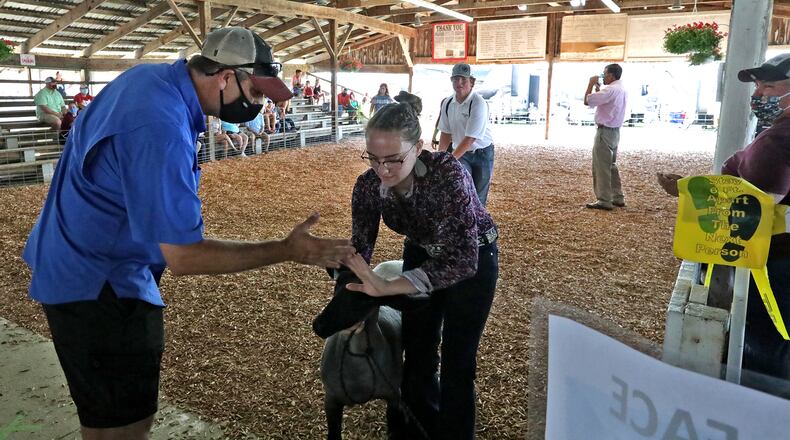That pandemic caused the fair to be shortened to five days from its usual eight and many typical events to be scrapped.
Members of the Clark County Combined Health District were on hand Saturday morning to inspect the grounds and told Clark County Fair executive director Dean Blair they were satisfied with what they saw.
Blair estimated he had seen about 80-percent compliance to the mask order and credited the county being upgraded to level 3 on Ohio’s COVID-19 risk level guidelines with increasing that number.
“I don’t think we would have that without those orders, but from our standpoint it didn’t change a thing about what we were planning,” Blair said. “We really did welcome that.”
Cavies and rabbits were first on the show docket Saturday. The latter moved to the renovated CTC Shelter House to make it an outside show. That allowed more attendees and made maintaining social distance easier.
Dairy cow and heifer showmanship also took place Saturday morning in a sparsely attended cattle arena, though that show and many others were being streamed online by NetSteady, a company out of Dublin, Ohio.
Nearby, the sheep showmanship competition took place in the sheep arena, and it was more of a normal scene.
Although spectators were seated in groups spread apart from each other and the judge wore a mask, the 4-H and FFA members in the ring did not have to.
Fair board member Stuart Waddle admitted to having some nerves being one of the first major large animals shows at a fair unlike any in recent memory.
“Basically I’m really trying to comply and make sure my species does not screw this up for everybody else,” Waddle said.
Although the board announced in June it would be holding only a junior fair – meaning no rides, games or grandstand entertainment – the stakes were raised last week when Ohio Gov. Mike DeWine warned fair managers in a conference call he had seen a lack of compliance with social distancing and crowd control at other fairs around the state that already took place.
Coronavirus: DeWine puts fairs on notice to follow guidelines https://t.co/i9V7ljGpNd
— Marcus Hartman (@marcushartman) July 23, 2020
That message included the prospect of a local health department shutting down a fair if it deemed necessary as more cases of COVID-19 continue to be found across the state.
“It’s taken months of planning, and our rules and plan of action has changed numerous times,” Waddle said. “We’re just doing the best we can to keep everybody in compliance.
“It seems like we’re getting a lot of voluntary compliance, and we’ve been on our announcer to keep reminding everyone if they’re in the barn they need to have a mask on.
“So far I think it’s gone really well. Our judge understood. He’s been more than willing to comply, and he’s done an excellent job as far as I’m concerned.”
Regular announcements made by the fair throughout the day include reminding people to maintain social distance, wear masks, wash hands frequently or use hand sanitizer.
Bleachers are also being sanitized three times per day while food and drinks are not allowed in the barns, and fair organizers also ask anyone who is feeling sick to stay home.
“The judge is wearing a mask, our stands are 50-percent full or less and everybody in the barn has to wear a mask. We have arrows marking one-way traffic in the barns, and we are trying to police that. It’s been rough, but everybody’s been doing their best.”
He said 114 lambs were weighed in Friday night, down 10-15 from a typical year, but showmanship participation was around what it normally is.
“Part of it’s COVID, and part of it is our species is a lot of hands on work,” Waddle said.
Another change this year as a result of the coronavirus pandemic: All auctions will be virtual.
What impact that has on participation – and how much money each exhibitor is able to get for their project – remains to be seen.
“It’s kind of wait-and-see,” Waddle said. “We’ve talked to a lot of our big buyers and they’re kind of excited for the way it’s going, but the board is just nervous. We’re hoping it takes off, but it’s the first year for it, A, and B, we’re just nervous. It’s something new and we don’t have really any information about it.”
Buyers must register at www.clarkcoaution.fairwire.com or www.clarkcoag.com, and the auction will be open from Aug. 3-10 for all species.
“Buyers can do what they normally do except from the comfort of their air-conditioned office,” Waddle noted while acknowledging anything new brings unknowns.
“We’re livestreaming the shows so they’re getting used to actually watching everything from a computer screen or whatever, but hopefully by the time the sale rolls around everybody will be used to that and they will get in a routine of watching, paying attention and supporting us,” he said.
About the Author

